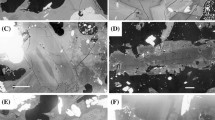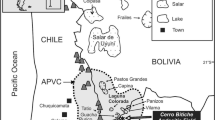Abstract
Gabbroic enclaves ejected during the current eruption phase (A-1) and during the latest prehistoric eruption phase (A-2) of Arenal Volcano show systematic variations in texture, mineralogy and composition as a function of host rock chemistry and timing of eruption. The most differentiated enclaves occur in the more differentiated A-2 lavas. Enclaves in the A-1 volcanics are consistently less evolved. Within the current A-1 eruption, the most mafic enclaves are amphibole-bearing rocks that were erupted during the first 2–3 years of activity (1968–1970). These enclaves occur in the most differentiated A-1 volcanics and are not in equilibrium with their host rocks. They crystallized from a hydrous melt that was slightly more mafic than anything erupted during the current cycle. We interpret the enclaves as sidewall crystallization products of a melt, possibly a high-alumina basalt, that was immediately parental to the A-1 lavas. Enclaves that occur in A-1 rocks erupted after 1970 and all of the A-2 enclaves are amphibole-free and less mafic than the early A-1 enclaves. Their chemistry suggests that they formed during the early to intermediate crystallization of their host lavas. None of the enclaves contain minerals that might have equilibrated with a primary, mantle-derived melt. Geothermometry is consistent with geochemistry, with amphibole-bearing A-1 enclaves yielding the highest pyroxene temperatures (ave. 1090° C) and A-2 enclaves the lowest (ave. 1030° C). Geobarometry suggests mid- to upper crustal depths for the crystallization of all enclaves. The enclaves are cognate and reflect pre-eruptive crystallization of Arenal magmas. They record evolution from a hydrous, basaltic magma to the drier basaltic andesites that characterize the current eruption. Volatiles appear to have been lost due to depressurization during the slow ascent of the magmas through the upper levels of the crust following the initial explosive eruption. Volatile loss and depressurization resulted in the destabilization and the progressive resorption of amphibole. The A-2 lavas may represent the long-term fractionation products of basaltic andesite magmas similar in composition to the A-1 lavas. Anorthitic plagioclase, commonly thought of as a phase stabilized by high Ca/Na and high water pressure, continued to crystallize in a system with relatively low Ca/Na and which had dehydrated and/or depressurized to the point at which amphibole was no longer stable. This suggests that compositional characteristics other than high Ca/Na or high water content may have stabilized the anorthite in the basaltic and basaltic andesite melts at Arenal. We speculate that the high-alumina content of the Arenal magmas may be the stabilizing factor.
Similar content being viewed by others
References
Anderson AT (1982) Parental basalts in subduction zones. J Geophys Res 87:7047–7060
Anderson DJ, Lindsley DH (1988) Internally consistent solution models for Fe-Mg-Mn-Ti oxides: Fe-Ti oxides. Am Mineral 73:714–726
Allan JF, Sack RO, Batiza R (1988) Cr-rich spinels as petrogenetic indicators: MORB-type lavas from the Lamont seamount chain, eastern Pacific. Am Mineral 73:741–753
Arculus RJ, Wills KJA (1980) The petrology of plutonic blocks and inclusions from the Lesser Antilles island arc. J Petrol 21:743–99
Baker DR, Eggler DH (1983) Fractionation paths of Atka (Aleutians) high-alimina basalt: constraints from phase relations. J Volcanol Geotherm Res 18:387–404
Baker DR, Eggler DH (1987) Compositions of anhydrous and hydrous melts coexisting with plagioclase, augite, and olivine or low-Ca pyroxene from 1 atm to 8 kbar: Application to the Aleutian volcanic center of Atka. Am Mineral 72:12–28
Barquero J (1978–1986) Boletin de Volcanologia. Escuela de Ciences Geograficas, Universidad Nacional, Heredia, Costa Rica, p 1–16
Barsdell M (1988) Petrology and petrogenesis of clinopyroxene-rich tholeiitic lavas, Merelava, Vanuatu. J Petrol 29:927–64
Beard JS (1986) Characteristic mineralogy of arc-related cumulate gabbros: Implications for the tectonic setting of gabbroic plutons and for andesite genesis. Geology 14:848–851
Beard JS, Day HW (1988) Petrology and emplacement of reversely zoned gabbro-diorite plutons in the Smartville complex, northern California. J Petrol (in press)
Borgia A, Linneman S, Spencer D, Morales LD, Brenez JA (1983) Dynamics of lava flow fronts, Arenal Volcano, Costa Rica. J Volcanol Geotherm Res 19:303–329
Borgia A, Poore C, Carr MJ, Melson WG, Alvarado GE (1988) Structural, stratigraphic, and petrologic aspects of the Arenal-Chato volcano system, Costa Rica: evolution of a young stratovolcanic complex. Bull Volcanol 50:86–105
Brophy JG, Marsh BD (1986) On the origin of high-alumina arc basalt and the mechanics of melt extraction. J Petrol 27:763–789
Buddington AF, Lindsley DH (1964) Iron-titanium oxide minerals and their synthetic equivalents. J Petrol 5:310–357
Burnham CW (1979) Magmas and hydrothermal fluids. In: HL Barnes (ed) Geochemistry of hydrothermal ore deposits, 2nd edn. Wiley, New York, pp 71–137
Carr MJ (1984) Symmetrical and segmented variation of physical and geochemical characteristics of the Central American volcanic front. J Volcanol Geotherm Res 20:231–252
Cigolini C, Borgia A, Casertano L (1984) Intra-crater activity, aablock lava, viscosity and flow dynamics: Arenal Volcano, Costa Rica. J Volcanol Geotherm Res 20:155–176
Cigolini C, Kudo AM (1987) Xenoliths in recent basaltic andesite flows from Arenal Volcano, Costa Rica: inference on the composition of the lower crust. Contrib Mineral Petrol 96:381–390
Conrad WC, Kay RW (1984) Ultramafic and mafic inclusions from Adak Island: crystallization history and implications for the nature of primary magmas and crustal evolution in the Aleutian Arc. J Petrol 25:88–125
Crawford AJ, Faloon TJ, Eggins S (1987) The origin of island arc high-alumina basalts. Contrib Mineral Petrol 97:417–430
Drake MJ (1976) Plagioclase-melt equilibria. Geochim Cosmochim Acta 50:457–465
Falloon TJ, Green DH (1986) Glass inclusions in magnesian olivine phenocrysts from Tonga: evidence for highly refractory parental magmas in the Tongan arc. Ear Plan Sci Letts 81:95–103
Fournelle J, Marsh BD (1988) Plagioclase equilibria and geothermometry in arc basalts and andesites: review and suggestions. EOS 69:p 731
Gilbert MC, Helz RT, Popp RK, Spear FS (1982) Experimental studies of amphibole stability. In: Veblen DR, Ribbe PH (eds) Amphiboles: petrology and experimental phase relations. Mineral Soc Am, Washington DC, p 229–354
Gill J (1981) Orogenic andesites and plate tectonics. Springer, New York Berlin Heidelberg, pp 390
Green DH, Ringwood AE, Ware NG, Hibberson WO (1972) Experimental petrology and petrogenesis of Apollo 14 basalts. Proc 3rd Lunar Sci Conf 1:197–206
Gust DA, Johnson RW (1981) Amphibole-bearing inclusions from Boisa Island, Papua New Guinea: evaluation of the role of fractional crystallization in an andesitic volcano. J Geol 89:219–232
Gust DA, Perfit MR (1987) Phase relations of a high-Mg basalt from the Aleutian island arc: Implications for primary island arc basalts and high-Al basalts. Contrib Mineral Petrol 97:7–18
Irvine TA (1974) Petrology of the Duke Island Ultramafic Complex, southeastern Alaska. Geol Soc Am Memoir 138
Johannes W (1978) Melting of plagioclase in the system Ab-An- H2O and Qz-Ab-An-H2O at \(P_{H_2 {\text{O}}} = 5\) kbars, an equilibrium problem. Contrib Mineral Petrol 66:295–303
Johnston AD (1986) Anhydrous P-T phase relations of near-primary high-alumina basalt from the South Sandwich Islands: Implications for the origin of islands arcs and tonalite-trondhjemite series rocks. Contrib Mineral Petrol 92:368–382
Le Bas MJ (1962) The role of aluminum in igneous clinopyroxenes with relation to their parentage. Am J Sci 260:267–288
Lindsley DH (1983) Pyroxene thermometry. Am Mineral 68:477–493
Malavassi E (1979) Geology and petrology of Arenal volcano. MS thesis, Department of Geology and Geophysics, University of Hawaii
Matumoto T, Ohtake M, Latham G, Umana J (1977) Crustal structure in southern Central America. Bull Seismol Soc Am 67:121–134
Melson WG, Saenz R (1968) The 1968 eruption of Volcan Arenal, Costa Rica: preliminary summary of field and laboratory studies. Smithsonian Center for Short-Lived Phenomena, Report 7:35p
Melson WG, Saenz R (1973) Volume, energy, and cyclicity of eruptions of Arenal Volcano, Costa Rica. Bull Volcanol 37:416–437
Myers JD (1988) Possible petrogenetic relations between low- and high-MgO Aleutian basalts. Geol Soc Am Bull 100:1040–1053
Reagan MK, Gill JB, Malavassi E, Garcia MO (1987) Changes in magma composition at Arenal Volcano, Costa Rica, 1968–1985: real-time monitoring of open-system differentiation. Bull Volcanol 49:415–434
Roedder RL, Emslie RF (1970) Olivine-liquid equilibrium. Contrib Mineral Petrol 29:275–289
Snoke AW, Quick JE, Bowman HR (1981) Bear Mountain igneous complex, Klamath Mountains, California: An ultramafic to silicic calc-alkaline suite. J Petrol 22:501–552
Spencer KJ, Lindsley DH (1981) A solution model for coexisting iron-titanium oxides. Am Mineral 66:1189–1201
Stern RJ (1979) On the origin of andesite in the northern Marianas island arc: Implications from Agrigan. Contrib Mineral Petrol 68:207–219
Stoiber RD, Carr MJ (1973) Quaternary volcanic and tectonic segmentation of Central America. Bull Volcanol 37:304–325
Wadge G (1984) The magma budget of Volcan Arenal, Costa Rica from 1968–1980. J Volcanol Geotherm Res 19:281–302
Wagner LR (1962) Igneous cumulates from the 1902 eruption of Soufriere, St. Vincent. Bull Volcanol 24:93–99
Author information
Authors and Affiliations
Rights and permissions
About this article
Cite this article
Beard, J.S., Borgia, A. Temporal variation of mineralogy and petrology in cognate gabbroic enclaves at Arenal volcano, Costa Rica. Contr. Mineral. and Petrol. 103, 110–122 (1989). https://doi.org/10.1007/BF00371368
Received:
Accepted:
Issue Date:
DOI: https://doi.org/10.1007/BF00371368




